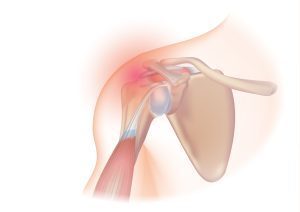
Most cases of shoulder pain can be attributed to an issue with the rotator cuff, a group of four muscles that stabilize the shoulder joint. Often, your physician will send you to get an x-ray and ultrasound of your shoulder to identify where the issue is coming from. If you have not had any trauma to your shoulder, your x-ray will very likely appear normal. However, your ultrasound results may be confusing. You may hear terms like partial tear and full tear. What do these mean? Does a tear in your shoulder mean you need surgery?
The answer is no, most tears do not require surgery, even if it is called a full tear. When we talk about tears in the shoulder, we are usually referring to a tear in one of the tendons that connect the rotator cuff muscles to the bones in your shoulder. But the terms partial tear and full tear do not actually give us all the information we need. In fact, when you look at your ultrasound report, you will rarely see those words used. Instead, it will say partial-thicknesstear or full–thickness tear. What’s the difference?
Imagine you have a delicious cake that you are going to divide into slices; this can represent any one tendon in your shoulder. You place the point of your knife in the center of the cake, and you begin to slice downwards. If you were to slice only halfway down and then brought the knife out, that would be a partial-thickness tear. But, if you went all the way to the bottom, that would be a full-thickness tear. In both cases, there is a slice in the cake, yet the cake is still one big piece.
Now imagine you have a really long knife, longer than the cake itself. You take this knife and slice right through the cake from end to end, creating two separate pieces, this would be considered a complete tear or complete rupture. This would possibly require surgery, because the two ends of the tendon are completely separated.
The main point here is that a full-thickness tear does not mean your tendon is completely split in two. A full-thickness tear may still be an incomplete tear, therefore the tendon can still function.
There are several other factors that will determine your recovery, such as the exact location of the tear, but now you know not to panic when you see that you have a full-thickness tear on your ultrasound report.
If you’re experiencing any shoulder pain, or would like to know more information, do not hesitate to book an assessment with one of our experienced physiotherapists!



